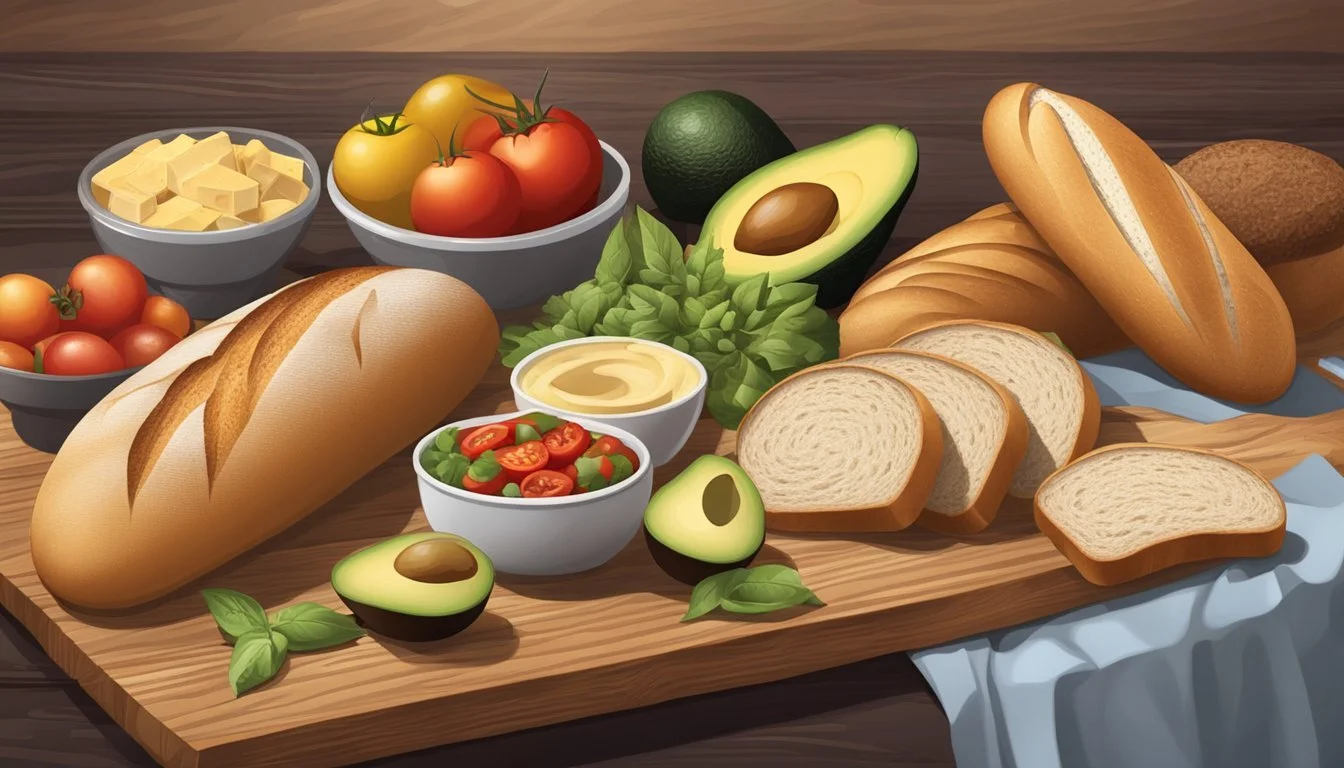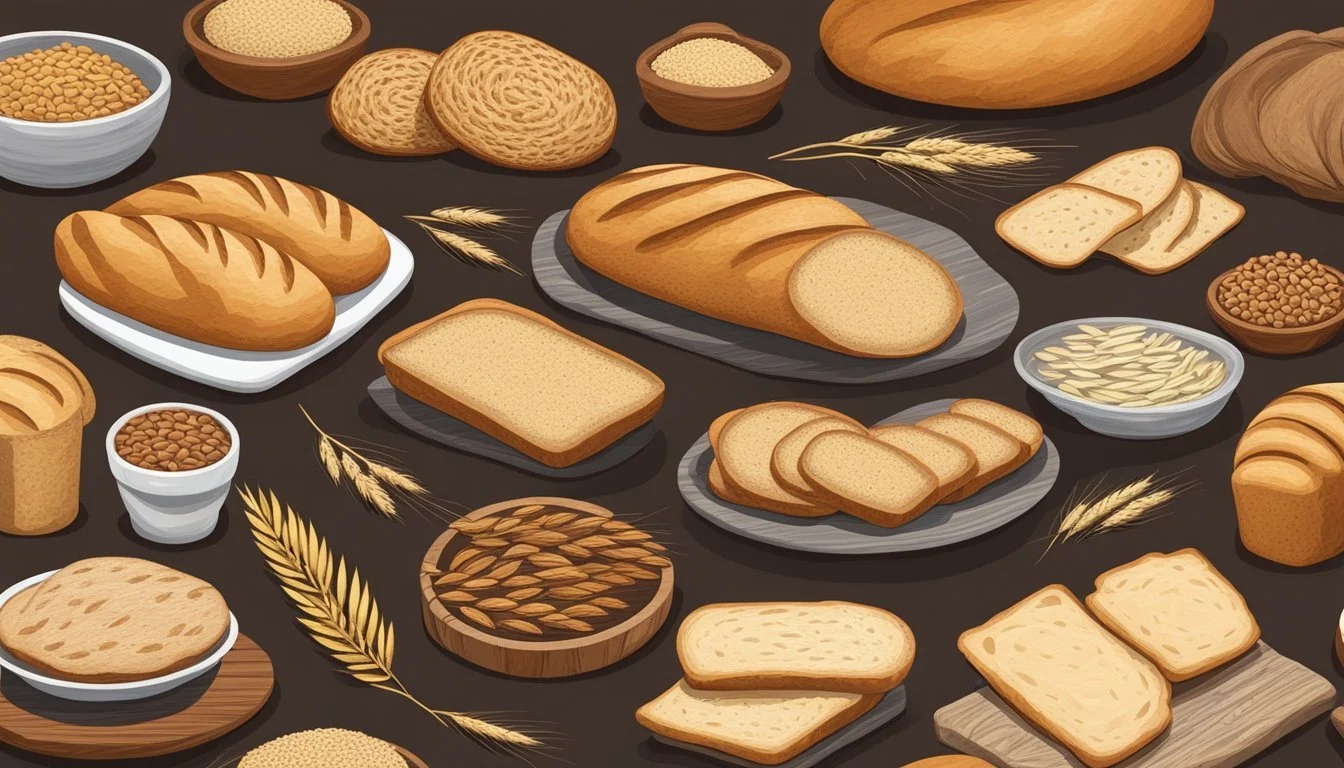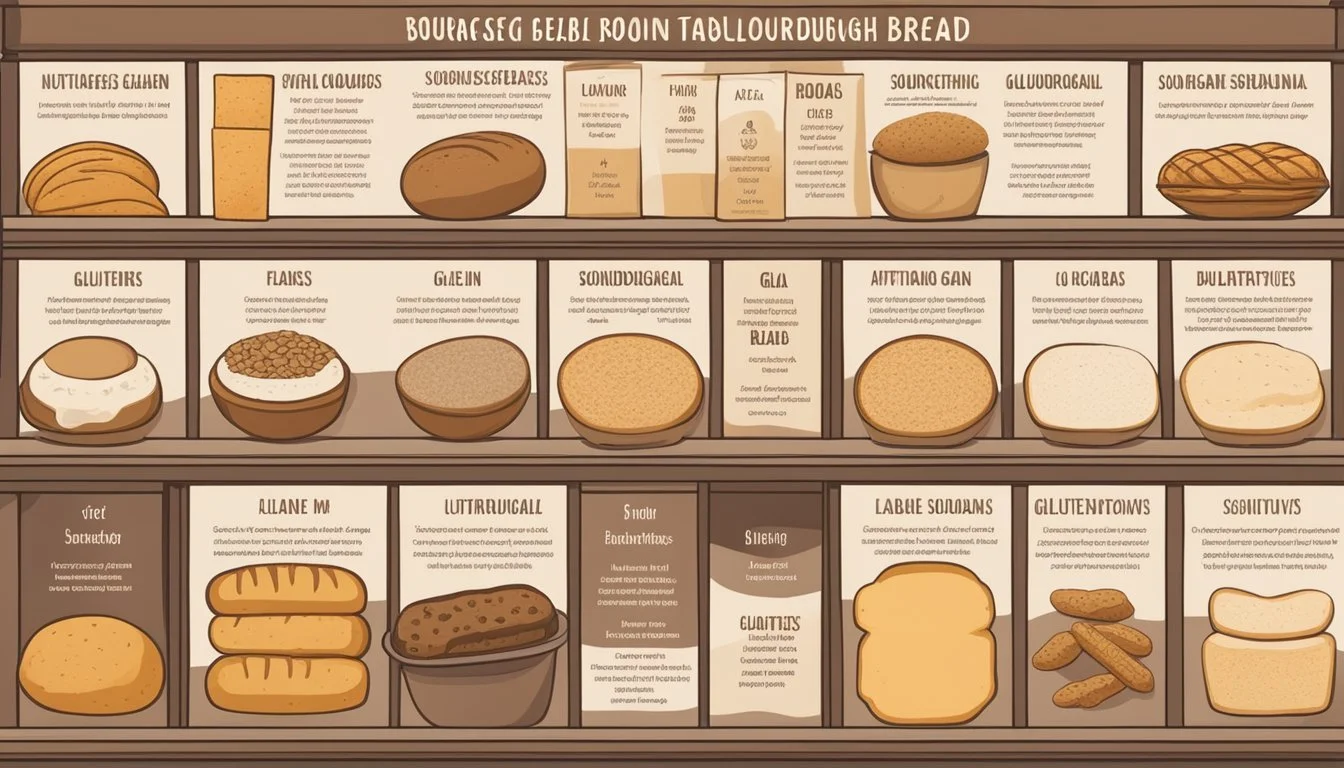Sourdough Bread Substitutes
Top Alternatives for Your Kitchen
Sourdough bread has long been treasured for its distinctive tangy flavor, chewy texture, and crisp crust—an artisanal staple that many bakers and bread enthusiasts swear by. Unlike conventional wheat bread, which relies on commercial baker's yeast for leavening, sourdough utilizes a starter comprising wild yeast and bacteria. The fermentation process initiated by this starter not only imparts a unique depth of flavor but also breaks down antinutrients, potentially enhancing the nutritional profile of the bread.
Opting for alternatives to traditional sourdough bread appeals to those looking to diversify their diet or to individuals with particular dietary needs, such as a reduced intake of carbohydrates or the avoidance of gluten. The alternatives range from utilizing other grains like rye, which is high in fiber, to completely grain-free options like lettuce wraps that suit a low-carb or keto lifestyle. Each alternative offers distinct textures, flavors, and nutritional benefits, providing an expansive array of choices for those seeking to replace conventional sourdough bread.
Understanding Sourdough
Exploring sourdough involves a dive into the complexities of fermentation and the myriad health benefits associated with this ancient form of bread. It invites an appreciation of the distinct character sourdough offers, largely due to its unique fermentation process and grain composition.
The Science of Fermentation
Sourdough bread’s characteristic taste and texture are the results of natural fermentation. This process relies on a sourdough starter, which is a culture of live active bacteria and wild yeast. During fermentation, these microorganisms break down the starches and gluten in wheat, leading to the production of organic acids and CO2. The resulting gases contribute to the dough's open crumb structure and tender texture, while acids develop the sourdough’s distinctive flavor.
Sourdough and Health Benefits
The combination of fermentation and whole grains in sourdough can offer several health advantages. Fermentation helps reduce the bread's FODMAP content, potentially aiding those with gluten sensitivity. Moreover, the presence of beneficial bacteria can positively impact gut health. The process also enhances the bread's nutritive profile, such as improved availability of B vitamins and key nutrients.
Wheat and Gluten in Bread
The types of wheat used in sourdough, be it whole grain or refined wheat, have implications for the bread’s gluten content and nutritional value. Whole grain sourdough will generally offer more fiber, protein, and nutrients compared to those made with refined wheat. While the fermentation process may make gluten more digestible, those with celiac disease should avoid sourdough as it contains gluten.
The Unique Character of Sourdough
Sourdough's uniqueness lies in its developed flavors and physical characteristics. The long fermentation allows for a complex flavor profile and a chewy texture. It is also recognized by its tender crumb and arguably more sophisticated taste compared to breads made with commercial yeast.
Bread Nutrition Information
Nutrient Expected Value (per 100g) Calories 250-300 Carbohydrates 50-60g Protein 8-12g Fiber 2-4g B Vitamins Varied*
*Values depend on wheat type and enrichment. Sourdough typically provides a portion of the daily recommended intake for B vitamins, with fermentation potentially increasing these levels compared to conventional breads.
Sourdough Bread Substitutes
Discovering a suitable replacement for sourdough bread means considering dietary needs and personal taste preferences. This section highlights several alternatives, ranging from gluten-free choices to low-carb options and nutrient-packed variations, each catering to different dietary requirements and culinary desires.
Gluten-Free Alternatives
Gluten-free breads are ideal for individuals with celiac disease, gluten intolerance, or those on a gluten-free diet. Common flours used in gluten-free baking include:
Rice flour
Corn flour
Buckwheat flour
Quinoa flour
These flours result in bread that mimics the hearty texture of traditional sourdough without triggering gluten sensitivities.
Low Carb and Keto-Friendly Options
For followers of a low-carb or keto diet, traditional bread's high carbohydrate content isn't suitable. Here are some low-carb substitutes:
Almond flour and coconut flour are frequently used to create satisfying, low-carb bread alternatives, such as cloud bread.
Lettuce wraps or collard greens can replace slices of bread, providing a crunchy vessel with minimal carbs.
Nutrient-Dense Substitutes
Incorporating legumes and sprouted grains into bread substitutes enriches the diet with additional nutrients compared to regular sourdough. Breads made from sprouted grains or legumes have higher levels of protein and vitamins.
Unique Bread Substitute Ideas
Experimenting with vegetables can result in unique and healthful substitutes for bread:
Bell peppers, mushrooms, and eggplants can be used as bases for sandwiches (What wine goes well with sandwiches?) or pizzas.
Sweet potato toast and cauliflower pizza crust offer a creative twist on traditional bread, adding more flavor and nutritional benefits.
Alternately, leaves of romaine lettuce or iceberg can hold sandwich ingredients together for a light and fresh option.
Non-Bread Alternatives
When seeking alternatives to sourdough bread for sandwiches, one can explore various non-bread options that offer nutrition, convenience, and flavor. These alternatives include wraps and rolls using vegetables or legumes, and bean-based creations that can substitute traditional bread in many recipes.
Creative Wraps and Rolls
An inventive approach for sandwich enthusiasts is to use leaves of vegetables as an alternative to bread. Lettuce wraps are a popular choice as they provide a crisp and fresh vessel for sandwich fillings. Large iceberg lettuce leaves are particularly well-suited for this purpose, offering both flexibility and a mild taste. Similarly, collard greens can be used as durable and nutrient-rich wraps. For a more nuanced flavor and additional texture, one might consider thinly sliced cucumbers or bell peppers as a bread substitute in rolls.
Vegetable-Based Solutions
Vegetables such as cauliflower have gained popularity for their versatility in the kitchen. Cauliflower can be processed into a fine rice-like texture and bound together with egg and spices to make a satisfying and low-carb bread alternative. Another robust option is mushrooms—portobello mushroom caps, in particular, offer a hearty and savory substitute for burger buns or sandwich bread. For individuals seeking something with a starchy note, thinly sliced and toasted rutabaga can provide a novel base for open-faced sandwiches.
Using Legumes and Beans
A flour alternative that can serve as a non-traditional bread is chickpea flour. It is especially favorable for those opting for gluten-free or high-protein diets. Chickpea flour can be used to make flatbreads or pancake-like creations called socca that are excellent for wraps or sandwich bases. Additionally, ground lentils and soybeans can be mixed with water and spices, then baked or cooked in a skillet to create firm, bread-like slices suitable for a variety of sandwich types. These legume-based substitutes offer a unique flavor profile while contributing additional protein to one’s diet.
Flours and Grains as Substitutes
When crafting sourdough bread, a baker can explore a diversity of flours and grains. These substitutions not only cater to dietary preferences but also add different flavors, textures, and nutrition profiles to the bread.
Gluten-Free Flours
Gluten-free flours are essential for those with celiac disease or gluten sensitivity. The key to gluten-free sourdough is finding flours that can mimic the properties that gluten typically provides, like elasticity and structure.
Almond Flour: Rich in protein and low in carbohydrates, almond flour brings a nutty taste to the bread.
Buckwheat: Despite its name, buckwheat is gluten-free and imparts a robust, earthy flavor.
Coconut Flour: High in fiber, coconut flour absorbs a lot of moisture, requiring bakers to adjust hydration levels in recipes.
Cassava Flour: It offers a neutral flavor and fine texture that resembles that of white flour.
Whole and Sprouted Grains
Whole and sprouted grains are unrefined grains that have not had their bran and germ removed by milling, making them richer in fiber and nutrients.
Whole Wheat Flour: More nutritious than white flour, it ferments more quickly due to its nutritional content.
Sprouted Grains: They have begun the germination process, which can enhance the bread's digestibility and nutritional value.
Other Grain Alternatives
Other grains can serve as either partial or complete substitutes in sourdough bread recipes, offering unique health benefits and flavors.
Spelt: An ancient grain with a slightly sweet and nutty flavor; it's easier to digest for some people than regular wheat.
Millet: This small-seeded grass adds a light, slightly sweet flavor and benefits from high versatility.
Quinoa: A complete protein source, quinoa can be made into flour and used in sourdough recipes.
Using Seeds and Nuts
Incorporating seeds and nuts into sourdough bread not only enhances the texture but also contributes additional nutritional benefits such as healthy fats, vitamins, and minerals.
Almond: Ground almonds can be added for flavor, or almond flour for bulk and protein content.
Quinoa: When cooked, it adds moisture and a slight crunch to the bread.
Sunflower Seeds: They introduce a mild, crunchy dimension to the texture and are rich in healthy fats.
Bread Substitute Preparation and Recipes
When considering bread substitutes, one must balance nutritional content, such as calories and carbohydrates, with taste and dietary needs, including options for gluten-free alternatives.
Home Baking Tips
Baking with alternatives to traditional bread flour can yield satisfying results, but requires precision. Almond flour is a gluten-free option that's lower in carbohydrates and high in protein, making it popular for gluten-free bread recipes. For best results, utilize recipes specifically designed for almond flour, as it behaves differently than wheat flour due to its higher fat content and lack of gluten. When using eggs in bread substitutes like cloud bread, it's important to whisk the egg whites to the right consistency to achieve a light, airy texture.
Store-Bought Bread Alternatives
For those seeking convenience, grocery stores offer various bread alternatives. Gluten-free bread options are commonly made from rice or potato flour. When shopping for these, it's important to compare nutritional labels as some may contain high levels of added sugars. Sweet potato slices can serve as a low-calorie, nutrient-rich alternative to toast. Another ready-to-eat option includes cauliflower pizza crusts, offering a lower-carb alternative rich in vitamins and fiber.
Simple Bread Substitute Recipes
Cloud Bread:
Ingredients: 3 eggs, 3 tablespoons cream cheese, ¼ teaspoon baking powder
Method: Separate egg whites and yolks. Beat whites with baking powder until stiff peaks form. Mix yolks and cream cheese, then fold into the whites. Spoon onto a baking sheet, bake at 300°F for 15-20 minutes.
Collard Green Wraps:
Ingredients: Large collard green leaves, hummus, desired fillings
Method: Blanch leaves, remove stems, spread hummus, add fillings, and wrap tightly.
Cauliflower Pizza Crust:
Ingredients: 1 head of cauliflower, 1 egg, seasonings, cheese (optional)
Method: Pulse cauliflower in a food processor, cook and drain well. Mix with egg, seasonings, and cheese. Shape into a crust on a baking sheet, bake at 400°F until crisp.
Each bread substitute varies in content of carbohydrates, proteins, and calories, providing options suitable for different dietary preferences and restrictions.
Health Considerations for Substitutes
When exploring sourdough bread substitutes, it's crucial to consider their effects on health, from nutritional value to allergen content.
Evaluating Gluten Sensitivity
For individuals with gluten sensitivity or celiac disease, choosing a substitute entails looking for gluten-free options. Gluten-free diets exclude wheat, barley, and rye but can include bread made from grains like rice or corn. Legumes, nuts, and seeds also provide bread-like alternatives without gluten.
Balancing Nutrients and Calories
Substitutes for sourdough bread should offer a balance of nutrients while not contributing excessive calories. Bread alternatives like whole grains and legumes provide protein, fiber, vitamins, and minerals, supporting a balanced diet. It is advantageous to compare the caloric content and nutritional density of substitutes to maintain dietary goals.
Understanding Glycemic Impact
Whole wheat and other whole-grain substitutes tend to have a lower glycemic index than white bread, meaning they affect blood sugar levels more gradually. Bread alternatives with low carbohydrates and high fiber can be favorable options for those managing their blood sugar, such as individuals with diabetes.
Bread Substitutes and Digestive Health
High-fiber bread substitutes, such as those made from vegetables or incorporating fermentation, contribute to a healthy gut bacteria population. Options that include fermented ingredients, like sourdough itself, can be particularly beneficial due to the fermentation process potentially aiding digestion and nutrient absorption.
Food Allergy and Intolerance Concerns
Selecting bread substitutes requires attention to potential food allergies and intolerances, notably to soybeans, nuts, and high-FODMAP foods. Substitutes must be chosen carefully, taking into account individual sensitivities to ensure digestive comfort and prevent allergic reactions.
Sustainable and Ethical Considerations
Bread substitutes should also be evaluated for their environmental impact. Ingredients sourced from sustainable farming practices reflect ethical consumption. Substitutes such as organic whole grains and products of local origin often have a lower carbon footprint, making them more sustainable choices.





